For this 10th episode of the Egyptian notebooks, the observation and chemical analysis of the representations of knives held by deities leads to a reflection on the nature of the metals that were used. Mummies moved by looters during antiquity are still present in this tomb originally built for Amenouahsou.
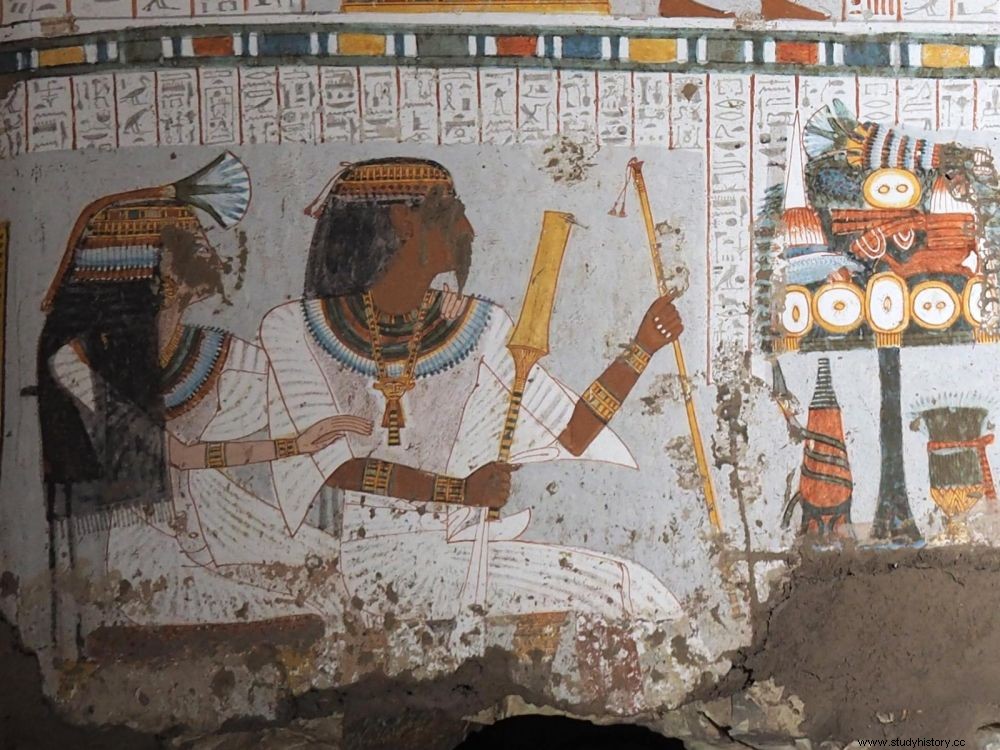
In the tomb of Amenouahsou, the father and mother of the artist seated in front of an offering table.
The research program on the practices of Egyptian painting is expanding every day. This season's campaign, which is longer than usual, follows three other one-week missions during which the research group coordinated by the Molecular and Structural Archeology Laboratory (Sorbonne University / CNRS) visited the Valley of the Nobles in Luxor. Research has already been carried out in the tomb of Amenouahsou who was "scribe of the sacred scrolls in the domain of Amon" (this distinguished artist certainly also taught the art of engraving and sculpture in the priestly school housed in the very heart of the Ramesseum). New measurements are however necessary to carry out some verifications.
"Amenouahsou was part of a large family of artists from the Ramesside era"
The owner of this tomb belonged to a family of royal artists, his father Samout having already been a draftsman in the service of the temple of Amun-Re at Karnak and one of the scribe-decorators of the Ramesseum, responsible for coloring the cartouches royals throughout the monument.
The paintings in this tomb from the time of Ramses II are particularly elegant, with effects of the transparency of clothing and a few scenes in which the artist's gestures (the physical act of painting) appear freed from all rules:on the figure of a vulture-headed deity, the clearly visible brushstrokes generate the shape of the beak and feathers. The yellow, red and blue lines overlap and intersect:they reflect fast, precise and committed gestures, made with a calame, i.e. a reed that could have been bevelled on one side for engraving. and crushed on the other for painting.
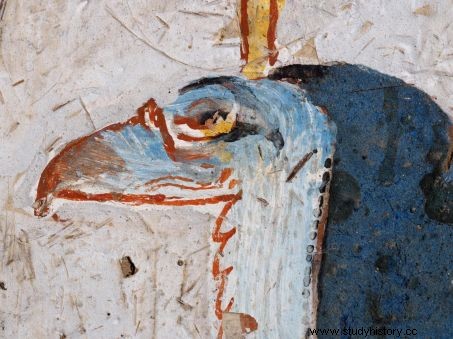
Detail of the head of a vulture-headed guardian deity, tomb of Amenouahsou. © MAFTO-LAMS CNRS
This deity, armed with a long knife, watches over one of the gates to the afterlife before which the deceased had to prove his knowledge by pronouncing the name of the guardian and reciting hymns to the gods. These passage examinations were numerous and are represented several times on the upper register of the paintings of the funerary chapel of Amenouahsou. These cutlery gods are depicted alternately with the head of a bovid, crocodile, lion, hippopotamus, vulture, etc. The blades of the knives are represented there with different colors and aspects:homogeneous or of variable tint, yellow, red, gray and sometimes bluish.
"The variety of knife blade colors is probably related to the different metals that were available"
These observations lead one to think that the artist who produced these representations may have sought to convey a message. Isn't it just the variety of metals that were available at the time? Most often, in other tombs, these knives appear yellow and we can think that they are gold blades.
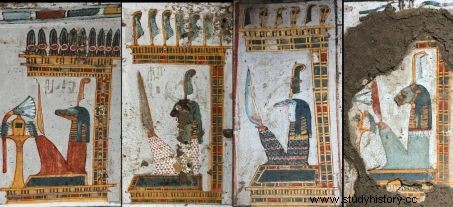
Some paintings of the guardian deities of the gates of the Beyond. © MAFTO-LAMS CNRS
ELECTRUM. This is also the case here, but the other colors can make one think of electrum (an alloy of gold and silver), silver itself, copper and its alloys rich in arsenic or tin (bronze ), or iron prepared, from the middle of the 2nd millennium BC, by metallurgical processes mastered by neighboring peoples, such as the Hittites. This same iron could also have an extraterrestrial origin because the fall of meteorites in the desert could have made it possible to harvest the precious metal, as has been shown by the analysis of a dagger discovered in the bandages which swaddled the mummy of Tutankhamen.
But the abandoned fragments of human bodies that we literally stumble over on our way to an adjoining space bring us back to a reality that is both sadder but just as meaningful:the shimmering monuments that we study are above all tombs. Long after the time of their conception and the death of Amenouahsou, they were used by generations to pile up the mummified dead in them by the hundreds.
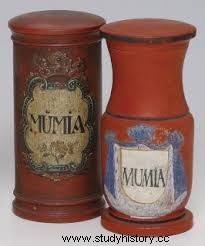
A mummy kept in the Cairo Museum. © MAFTO-LAMS CNRS
"The fate of Egyptian mummies varied greatly in recent periods of our history"
In the 19th century, these often late mummies, made at a time when the art of thanatopraxy had become less expensive and involved many layers of society, were a wealth that modernizing Egypt did not really know what to do with. The most beautiful of them were autopsied in educational sessions appreciated by high society. According to Mark Twain in 1869, the greatest number nevertheless ended up burned in the furnaces of locomotives between Cairo and Luxor, with drivers openly complaining about the poor heat-insulating quality of these past rulers.
Many of them were also ground into powder before being spread in the English countryside to fatten the farmlands of Sussex. One of the largest paper mills in England was also proud to produce paper from ancient strips torn from mummies and brought back from Egypt in whole shipments.
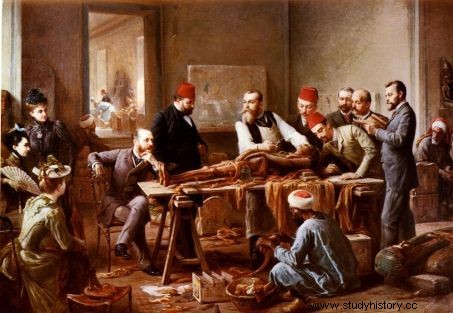
Unbandaging one of the mummies in the Deir el Bahari Hideout. Paul Dominique Philippoteaux circa 1895. © Wikipedia Commons
But earlier, in times when their costly exoticism made them more valuable, the dark bodies of ancient Egyptians, miraculously preserved, met even more astonishing fates. Since the Middle Ages, their black color has been mistakenly compared to the Persian bitumen to which Greek medicine gave curative virtues by making an unexpected panacea. Presumed incorruptible, they are also supposed to transmit to the patient part of their unaltered vital qualities.

Pharmaceutical jars containing mumia. © Wikipedia Commons
From the 16th century, the importation of mummies became a flourishing trade and the richest got into the habit of ingesting them on a regular basis. François I never travels without having a little mumia on him, soon followed by Catherine de Médicis then many courtiers who, in the event of an accident, then mix this naturally anticoagulant product with wine and ingest it. The mumia is then perceived as a universal remedy that protects against calamities, soothes all pain and treats hemorrhages, dislocations and other traumas. In 1462, the mumia was sold in Alexandria for twenty-five gold crowns per quintal, a real fortune!
Notebooks of Egypt, 1st episode:how did the painters of ancient Egypt work?
Notebooks from Egypt, 2nd episode:Discovering the funeral chapel of Nakhtamon.
Notebooks from Egypt, 3rd episode:The pigments of Egyptian painting.
Notebooks from Egypt, 4th episode:The modern documentation of painted walls.
Notebooks from Egypt, 5th episode:Rediscovering the monuments of eternity of Ramses II.
Notebooks from Egypt, 6th episode:Revealing pigments with light:the visible and the invisible.
Notebooks from Egypt, 7th episode:Experiencing research through images.
Notebooks of Egypt, 8th episode:Beginning of the study of the paintings of the tomb of Nebamon and Ipouky.
Notebooks from Egypt, 9th episode:A tomb shared by two artists under Amenhotep III.
Notebooks from Egypt, 10th episode:What the tomb of Amenouahsou, an artist from ancient Egypt, reveals.
Notebooks from Egypt, 11th episode:Strange uses that have been made of Egyptian mummies.
Notebooks from Egypt, 12th episode:"Why don't all the artists come here?"
Notebooks of Egypt, 13th episode:Why did the Egyptians draw the characters in profile?
Notebooks from Egypt, 14th episode:Observing craft practices in Egyptian tombs.
Notebooks from Egypt, 15th episode:About Egyptian perfumes.
Notebooks from Egypt, 16th episode:The colors of the Egyptian palette.
Notebooks of Egypt, 17th episode:The Egyptian language does not know a word to designate "art".
Notebooks of Egypt, 18th episode:The day of a scientific mission in Egypt.
